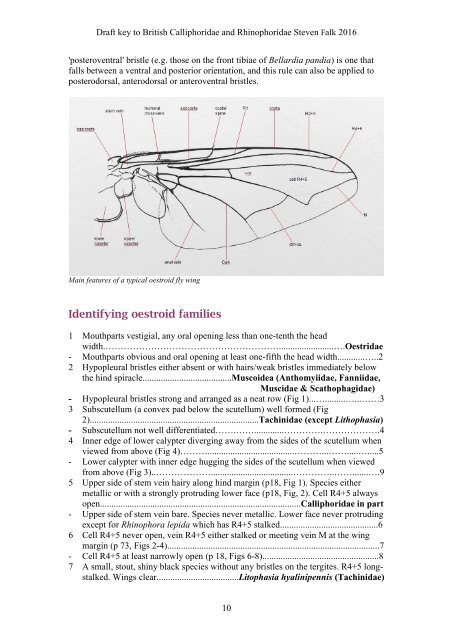BRITISH BLOWFLIES (CALLIPHORIDAE) AND WOODLOUSE FLIES (RHINOPHORIDAE)
4cmTmdCuA
4cmTmdCuA
Create successful ePaper yourself
Turn your PDF publications into a flip-book with our unique Google optimized e-Paper software.
Draft key to British Calliphoridae and Rhinophoridae Steven Falk 2016<br />
'posteroventral' bristle (e.g. those on the front tibiae of Bellardia pandia) is one that<br />
falls between a ventral and posterior orientation, and this rule can also be applied to<br />
posterodorsal, anterodorsal or anteroventral bristles.<br />
Main features of a typical oestroid fly wing<br />
Identifying oestroid families<br />
1 Mouthparts vestigial, any oral opening less than one-tenth the head<br />
width.…………………………………………………........................….Oestridae<br />
- Mouthparts obvious and oral opening at least one-fifth the head width............…..2<br />
2 Hypopleural bristles either absent or with hairs/weak bristles immediately below<br />
the hind spiracle.......................................Muscoidea (Anthomyiidae, Fanniidae,<br />
Muscidae & Scathophagidae)<br />
- Hypopleural bristles strong and arranged as a neat row (Fig 1)...….........…...……3<br />
3 Subscutellum (a convex pad below the scutellum) well formed (Fig<br />
2)..........................................................................Tachinidae (except Lithophasia)<br />
- Subscutellum not well differentiated…….…….............………….……………….4<br />
4 Inner edge of lower calypter diverging away from the sides of the scutellum when<br />
viewed from above (Fig 4)………......................................………...…….....….....5<br />
- Lower calypter with inner edge hugging the sides of the scutellum when viewed<br />
from above (Fig 3)..………………....................................…………..…….......….9<br />
5 Upper side of stem vein hairy along hind margin (p18, Fig 1). Species either<br />
metallic or with a strongly protruding lower face (p18, Fig, 2). Cell R4+5 always<br />
open........................................................................................Calliphoridae in part<br />
- Upper side of stem vein bare. Species never metallic. Lower face never protruding<br />
except for Rhinophora lepida which has R4+5 stalked...........................................6<br />
6 Cell R4+5 never open, vein R4+5 either stalked or meeting vein M at the wing<br />
margin (p 73, Figs 2-4).............................................................................................7<br />
- Cell R4+5 at least narrowly open (p 18, Figs 6-8)...................................................8<br />
7 A small, stout, shiny black species without any bristles on the tergites. R4+5 longstalked.<br />
Wings clear....................................Litophasia hyalinipennis (Tachinidae)<br />
10


